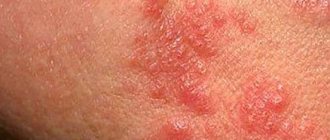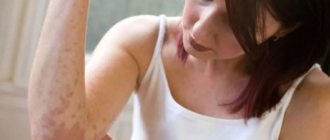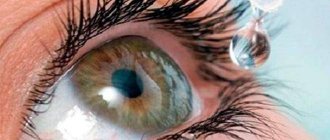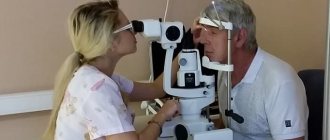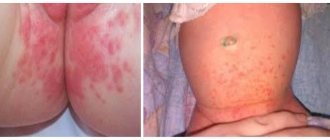Last update: 03/03/2021
Facial dermatitis is a facial skin disease that is inflammatory in nature. It manifests itself in the form of redness of the skin, noticeable rashes, accompanied by peeling and itching.
The disease affects the face, which causes not only physical discomfort and pain, but also psychological problems. Therefore, dermatitis on the face needs to be treated.
Perioral dermatitis
Perioral dermatitis on the face is a disease that affects the skin.
It appears in the form of small pimples that form in the area of the lips and mouth. It is accompanied by unpleasant itching, redness and negative consequences, which can be eliminated through a medical examination and properly selected treatment. In each specific situation, based on the results of the consultation, doctors recommend the patient medications that are relevant to his case. These include specialized pastes, ointments, sometimes hormonal drugs, as well as therapy that quickly eliminates burning and other symptoms. For perioral dermatitis, medications (ointment, tablets, cream) are selected based on medical diagnosis and tests. You can purchase the necessary medications for treatment on our website “Pharmacy 911”.
About the procedure
Perioral dermatitis
is a facial skin disease characterized by the appearance of small papules and pimples in the chin area and around the lips, redness and irritation of the skin in the affected areas.
Typically, perioral dermatitis occurs in women aged 17 to 30 years, and at first, patients, confusing it with acne, do not consult a dermatologist, trying to get rid of the disease on their own.
However, cosmetic products for acne do not give results and, moreover, they can provoke the spread of dermatitis and an increase in the area of the affected areas.
Read on topic:
Face lifting with APTOS threads
Causes of perioral dermatitis
Various factors become prerequisites for the occurrence of the disease. It is generally accepted that the disease can occur in waves, during which the irritation on the skin passes and reappears. Doctors often identify hormonal changes as the cause of perioral dermatitis. Symptoms appear as a result of:
- the use of drugs based on corticosteroids, which provoke the occurrence of rosacea, acne, blackheads and other cosmetic problems
- pregnancy, when the body is at the stage of serious changes and hormonal changes. Dermatitis often worsens before the onset of menstruation.
- using inappropriate decorative cosmetics
- the use of pastes with fluoride, which provoke irritation of the epidermis
- chapping after walking in the cold or sunbathing
- infectious diseases
- problems with immunity. They are usually caused by not getting enough vitamins.
Having discovered a corresponding problem, it is better to immediately go to see a doctor and find out how to treat perioral dermatitis on the face in adults.
Atopic dermatitis and foods that cause it
Foods that are recommended to be limited or completely excluded by a nursing woman:
- Any kind of nuts, including peanut butter, which is commonly found in ice cream or chocolates;
- Strawberries;
- Honey;
- Red fish or any aquacultured (pool-grown) fish and seafood;
- Ketchup;
- Mayonnaise;
- Whole cow or goat milk;
- Any pickles, smoked meats, salami or cervelat, etc.
The nutrition of future and existing young mothers should be 100% natural!
Symptoms of the disease
The first sign that you need to undergo an examination is the appearance of small blisters (papules) in the mouth and chin. In severe cases, they can spread throughout the face, reaching the cheeks, nose, eyes and temples. Papules are filled with clear liquid. Color varies from flesh-colored to pink to bright red depending on the stage of the disease. Pimples appear singly or in groups. The skin in these areas becomes rough. Bursting, papules form crusts. If you accidentally touch one, pigmentation will eventually remain on the skin.
Patients do not always experience serious pain. The sooner treatment of perioral dermatitis on the face in children and adults begins, the easier it is to get rid of the disease, and the lower the risk of unpleasant consequences. When you notice the first symptoms of the disease, make an appointment with a dermatologist.
Varieties
There are three main types of seborrheic dermatitis:
- dry – with reduced production of sebaceous secretions, excessive exfoliation of the skin, the formation of dense dry crusts, cracking of the skin and hair loss;
- oily – with a change in the composition of sebum and an increase in its production, the formation of red spots on the skin and yellow, easily separated crusts;
- mixed - with the appearance of oily crusts on the scalp and dry seborrhea on the face, the most severe type of disease.
A relatively mild form of seborrhea is dandruff - the formation of particles of exfoliated skin on the scalp.
Risk groups and similar diseases
Signs of the disease are most often found in women, but children and adolescents periodically experience them due to weakened immunity. In place of the blisters, ulcers often form. When spread over the entire face, it becomes a threat to vision, which is especially important in the situation with children. Therefore, when checking with a specialized doctor about how to treat perioral dermatitis in children, it is worth paying a visit to an ophthalmologist.
In the case of teenagers, the disease may not be detected immediately, because, experiencing hormonal changes, boys and girls often encounter skin problems. Blackheads and acne affect most people, so it can be difficult to notice papules at an early stage. Patients prone to allergies also rarely accurately diagnose the disease. Perioral dermatitis in children is often attributed to hormonal imbalance.
Atopic dermatitis and infant formula nutrition
Of course, most modern mothers, despite any difficulties, will try to feed their baby with their milk. If the mother is healthy and does not take antibiotics or any other chemotherapy drugs, then breastfeeding is the best thing she can give her baby.
There are cases:
- The mother herself suffers from allergies or food intolerance to some foods, which force her to maintain such a strict diet that it becomes a real torment for both her and her child. But the rashes still continue;
- There is simply no milk.
In these cases, it is necessary to transfer the child to artificial feeding. The main thing you must learn and remember from this part of the article is that the so-called hypoallergenic mixtures are LOW allergenic, and not completely non-allergenic. That is, hypoallergenic formulas (HA) are intended for feeding children with a predisposition to allergies, but not for children with obvious diathesis.
Diagnosis of perioral dermatitis
Having noticed the first signs of the disease, having felt unpleasant symptoms, you need to make an appointment with a specialized specialist. The initial appointment with a doctor consists of an examination, a description of the medical history based on the patient’s complaints and information about the individual characteristics of his body and possible reactions.
Before treating perioral dermatitis, tests are one of the mandatory procedures. They allow you to identify the prerequisites for the development of the disease and accurately diagnose it, without confusing it with herpes, rosacea and other skin lesions. You will need:
- Dermatoscopy. Gives an assessment of the epidermis and helps assess the course of the disease
- Scrapings. Determine the infectious nature if the symptoms have a corresponding origin
- Allergy tests. Demonstrate the level of skin sensitivity to staphylococcus and streptococcus
As a result of the examination, the doctor explains to the patient how to cure perioral dermatitis, clinical recommendations are entered into the disease record. A course of medications and therapy is prescribed.
Treatment of perioral dermatitis
A confirmed diagnosis usually requires an integrated approach. The treatment regimen involves a complete refusal of cosmetics, as well as corticosteroid drugs. The patient is advised to use antihistamines to relieve burning and itching. Herbal lotions are used to help reduce inflammation. Reflexology is used to stop symptoms by pressing on specific points or placing special needles.
Having weakened the symptoms, you can resort to the use of antibiotics to get rid of the infection if it is diagnosed during the examination. For perioral dermatitis, medications are prescribed by a doctor taking into account age, body characteristics, allergies and pregnancy. Strengthening the immune system and restoring the balance of intestinal microflora are important. The latter may require a specific diet. Avoid fried, spicy and fatty foods, snacks, sweets and fast food. Give up alcohol and cigarettes.
Prevention
Treatment with ointment for perioral dermatitis is not always a panacea. In some cases, the disease can return, so the course of taking medications can be long. Any irritant often leads to the appearance of the disease. Following simple recommendations will help you avoid possible risks:
- Check the composition of cosmetic products and treat their choice with special attention
- Don't neglect personal hygiene
- Strengthen your immunity
- Eat right and monitor your digestive health
- Be aware of allergies
- Monitor hormonal balance during pregnancy, in case of possible changes due to nervousness, illness or other reasons
Perioral dermatitis detected at the first stage is the easiest and fastest to treat, so remain sensitive to the body’s signals and begin the fight against the first symptoms of the disease in a timely manner.
Seborrheic dermatitis: diet in adults
Compliance with special nutritional rules is an important addition to the main therapy. The basic rules are simple:
- exclusion of fatty and fried foods, spicy seasonings, smoked foods, sweets;
- increasing the share of fermented milk products, raw and processed vegetables and fruits;
- consumption of lean meat, poultry, fish;
- replacing animal fats with vegetable oils;
- fractional meals.
You should listen to your body and make adjustments to your diet if your skin condition worsens, excluding foods that cause a negative reaction from the menu.
The listed measures should in no way be taken as a guide to action. Seborrheic dermatitis should be treated only under the supervision of a dermatologist, who should be contacted immediately after the appearance of alarming symptoms. If the disease affects the scalp, you will need the help of a trichologist - a doctor specializing in hair treatment. Do not delay your visit to the clinic, because the sooner treatment is started, the faster your health will be restored.
Bibliography
- Adaskevich V.P. Perioral dermatitis: clinical picture, diagnosis, treatment / V.P. Adaskevich // Dermatology. – 2008. – No. 1. – P. 17–20.
- Grashkin V. A. Diagnostic criteria, epidemiology and substantiation of clinical and pathogenetic types of perioral dermatitis / V. A. Grashkin, M. S. Gromov // Voenmed. magazine – 2010. – No. 10. – P. 32–45.
- Rodionov A. N. Dermatocosmetology. Lesions of the facial skin and mucous membranes. Diagnostics, treatment, prevention / A. N. Rodionov. – St. Petersburg. : Science and technology, 2011. – 912 p.
- Karelina O. Yu. Perioral dermatitis: treatment with azelaic acid / O. Yu. Karelina, Yu. M. Karelin // Klin. dermatology and venereology. – 2006.
Popular questions about perioral dermatitis
How can you get perioral dermatitis?
Dermatitis is not contagious, as it is an individual reaction of the body to the use of fluoride-containing pastes, inappropriate cosmetics and drugs containing corticosteroids. In the case of diagnosing infectious preconditions for a disease, it is worth finding out its nature, but it will not become a reason to limit communication.
How does perioral dermatitis manifest?
The disease is characterized by the formation of papules, blisters filled with colorless liquid, which spread around the mouth and along the chin, rising to the eyes. Dry skin, itching and burning accompany the disease, but in the first stage patients experience minimal discomfort.
Is it possible to cure perioral dermatitis?
The disease is easily treatable if you follow your doctor’s recommendations, use the necessary medications and avoid products and products that can cause perioral dermatitis. Depending on the extent of the damage, the course can take from several days to several months.
